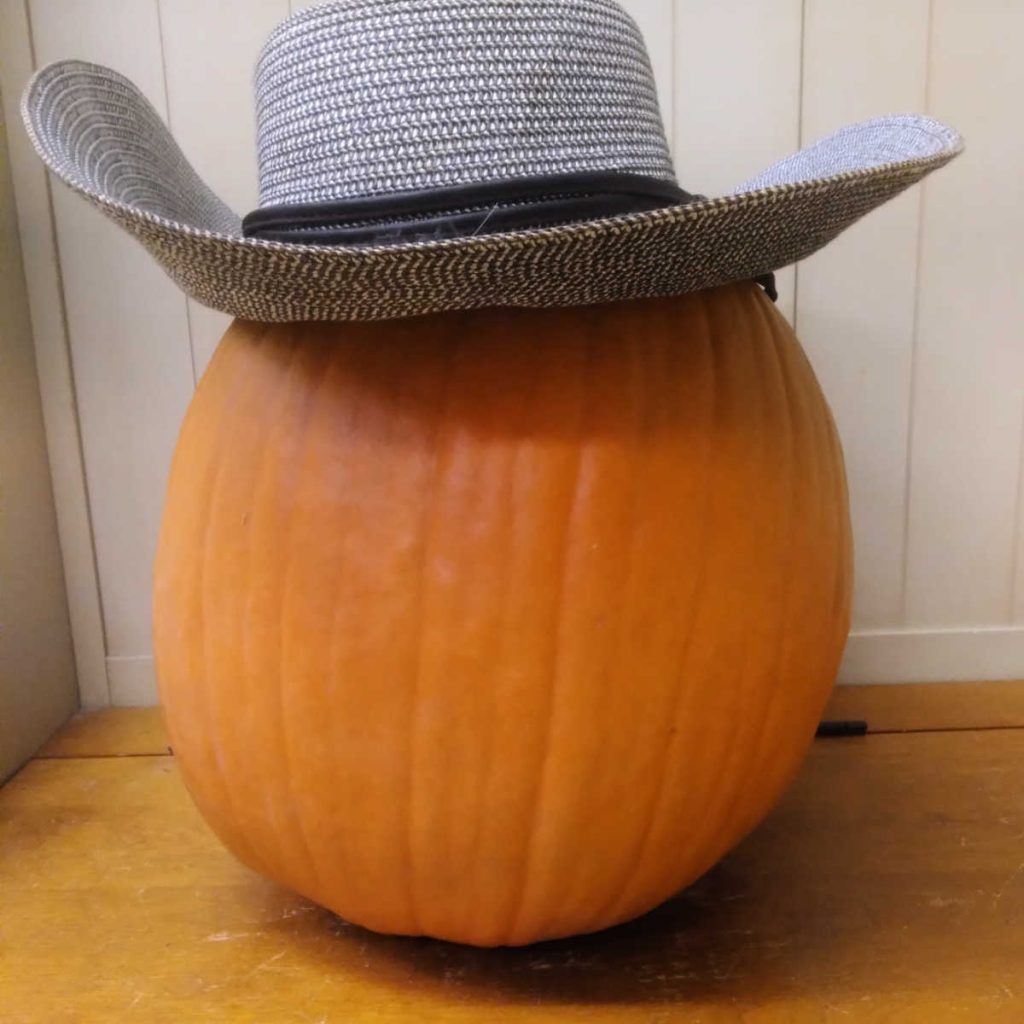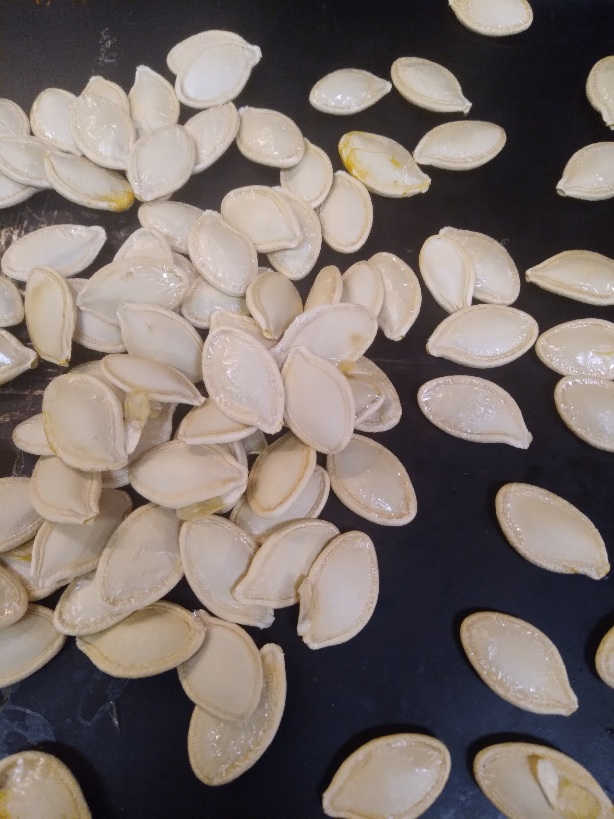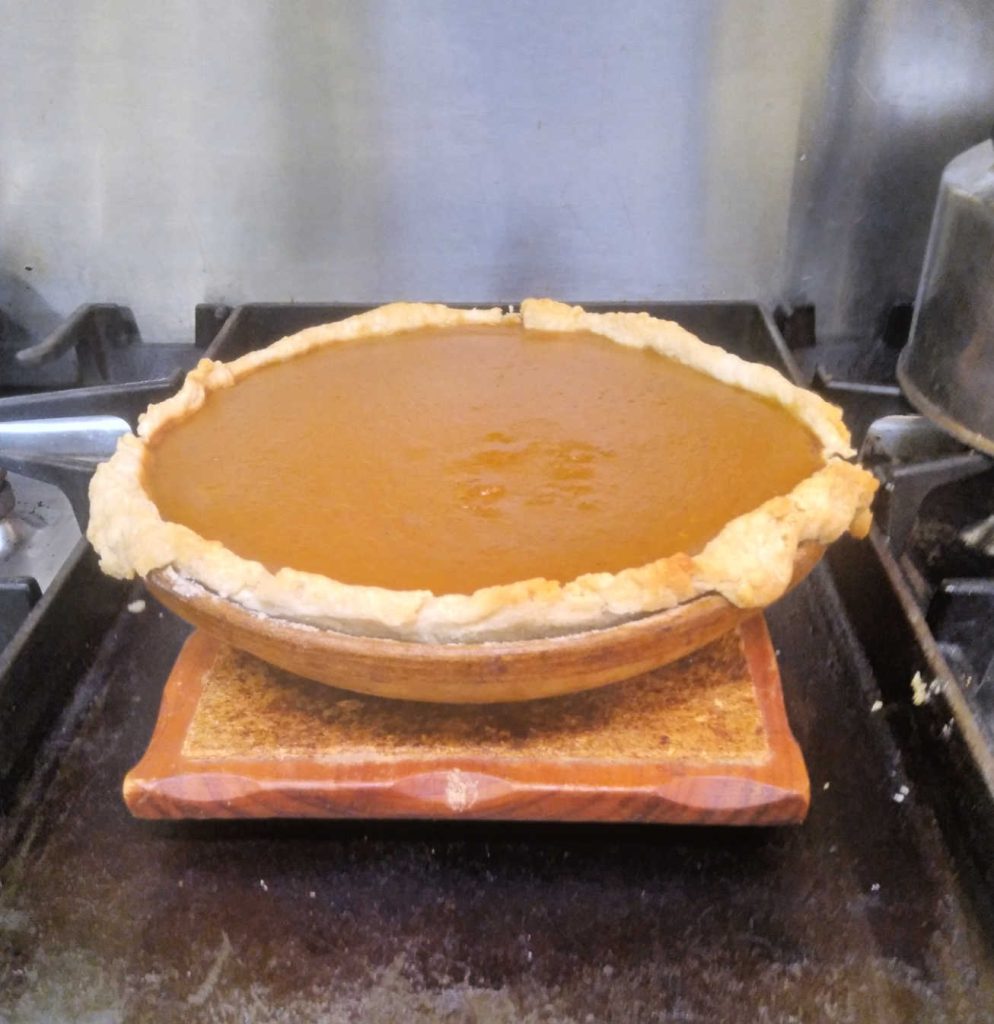I never imagined we would get so much use from a $3 store-bought pumpkin!
I love decorating for fall with a fresh pumpkin. My husband found one on clearance at Kroger (our local supermarket) the last week of October—$3 for this huge beauty! (Hat not included—it wore my gardening hat for Halloween trick-or-treating.)

Instead of carving it into a jack-o-lantern, he asked me to leave it whole so he could try to make a pumpkin pie from scratch for Thanksgiving. He remembered how his mother had done this when he was a child, and he wanted to recreate her recipe this holiday season.
So, we kept the pumpkin intact (we did not cut into the skin) and kept it in the kitchen. Then, last weekend, we began cooking fresh pumpkin in multiple dishes. Here is how we used a fresh pumpkin in multiple ways.
How to Use Fresh Pumpkin
Cooking with fresh pumpkin is a multi-day affair. On Sunday, we peeled and cooked the pumpkin, turning it into puree and roasting the seeds, and then my husband made pies on Tuesday.
We chose to clean, save, and roast the seeds since I enjoy snacking on pumpkin seeds. The seeds must be separated from the fibrous strands, washed, dried, and then roasted.
While we may think of pumpkins as purely decorative or perhaps tasty in a pie, they are a powerhouse of nutrition. These low-calorie squash family members offer plentiful beta carotene, or Vitamin A, which is known to reduce the risk of certain types of cancer and protect against asthma and heart disease (according to Medical News Today).
Additionally, pumpkins provide Vitamin C, magnesium, and other anti-oxidants, which offer excellent nutritional value for a few calories when eaten as part of a plant-based diet.
What Does Pumpkin Taste Like?
Okay, so you may be sold on eating that fall decoration. But what does it taste like?
I find that pumpkin tastes like a very mild version of butternut squash. You can substitute pumpkin for butternut squash in many recipes. The taste is very mild and sweet. Traditional pumpkin spices: cinnamon, nutmeg, and ginger, amp up the flavor.
How to Cook Fresh Pumpkin
There are several ways to prepare and cook fresh pumpkin. We chose to peel and slice the pumpkin, boil it in cubes, cool and drain it, and puree it in the food processor. I’ll provide directions below.
Others recommend roasting the pumpkin in the oven. McCormick (the spice company) provides directions on how to turn a pumpkin into a puree, with roasting as their preferred method.
There are certain advantages of roasting over boiling when turning a fresh pumpkin into puree for recipes. First, boiling introduces additional water, which can make the puree runny. Fresh pumpkin is already moist, and the added water may create a too-watery puree; you’ll have to adjust your recipes accordingly, adding more flour or cutting back on other liquids to get just the right batter consistency. While this may not sound difficult, it can be challenging if you are not an experienced cook or using a new recipe.
I find roasting pumpkin and other squashes more challenging. It takes longer than boiling, and if I don’t watch my oven carefully, the pumpkin browns, introducing a little charred flavor into the mix that’s fine for soup but unpleasant in baked goods.
Use the method that makes the most sense to you. We boiled ours, so that will be in the instructions I provide below.
Cooking Fresh Pumpkin by Boiling
Follow these instructions to cook fresh pumpkin using simple boiling water. Be careful when using a knife on a pumpkin, as the flesh can be hard, and the knife can slip.
- Use only a whole pumpkin that has not been carved, painted, or sprayed with preservatives.
- Wash and dry the outer skin.
- Use a knife to slice off the stem end.
- Scoop out the fibrous interior and seeds.
- If you plan to roast the pumpkin seeds, place the fibrous matter and seeds into a colander (instructions below).
- Run cold water over it to separate the material from the seeds
- Place the seeds on a clean or paper towel and pat dry for later use.
- Cut the pumpkin in half, then cut the halves into two.
- Use a sharp knife and slice the flesh carefully from the rind. Discard the rind into the compost pile.
- Slice the orange flesh into cubes.
- Place cubes into a large pot of water and bring to a boil.
- Boil for 5 – 8 minutes. Check after five minutes by testing the cubes with a fork. If they are soft, it’s time to take it off the heat. The fork should pierce them easily.
- Drain the pot of pumpkin and water into a colander, allowing the pumpkin to cool and drain as completely as possible (about one hour).
- Use a food processor to puree the pumpkin. Place cooked cubes into the food processor and puree according to the instructions for your machine.
- Spoon the puree into glass containers, such as large Mason jars, cap them, and place in the refrigerator. Use fresh puree as soon as possible. Refrigerate for up to one week.
How to Roast Pumpkin Seeds
Here’s a very simple method to roast pumpkin seeds. These seeds are tasty enough on their own and do not need oil or salt. This makes them compatible with the Eat to Live or nutritarian diet.

- Preheat oven to 250 degrees F.
- Place washed and dried pumpkin seeds on a baking sheet.
- Bake for one hour, stirring occasionally.
- Allow to cool. Place in a container to store and eat within a week.
That’s it! If the seeds aren’t dry enough, leave them in the oven a little longer.
So, how did the pie come out?
This is the 1950s, entirely from scratch (crust and all) recipe. It came out great, with a silky texture to the pumpkin filling. It could have used a few more spices, but overall, it was a great pie.






